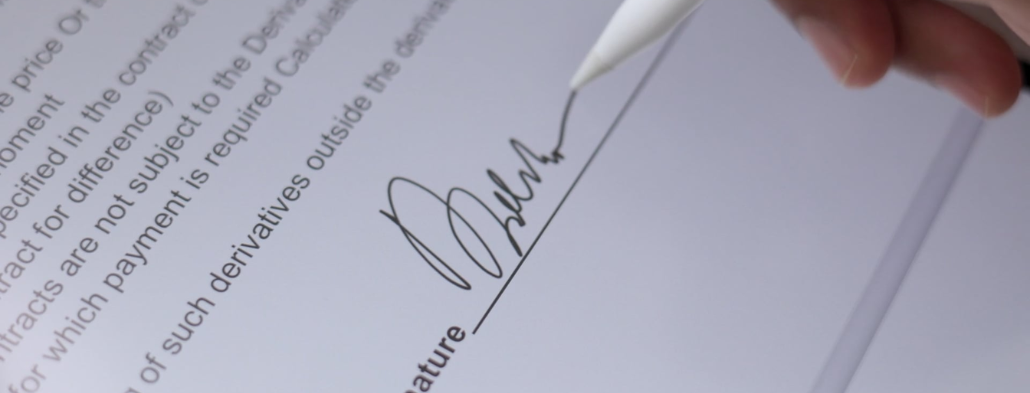You can create a digital signature using trusted e-signature platforms like RSign, which provide simple tools to sign PDFs online securely.
A digital signature is a cryptographic mechanism that uses advanced mathematical algorithms and public key infrastructure (PKI) to verify the identity of the signer and ensure the document hasn't been tampered with after signing. Unlike traditional handwritten signatures, digital signatures create a unique digital fingerprint that provides authentication, integrity, and non-repudiation for electronic documents and communications.
While these terms are often used interchangeably, there are important distinctions between digital signatures and electronic signatures that impact security, legal compliance, and business applications.
Electronic signatures serve as a broad umbrella term encompassing any electronic indication of intent to sign a document. This includes simple methods like typing your name in a signature field, clicking an "I agree" button, or using a stylus to create a handwritten signature on a touchscreen device. Electronic signatures focus primarily on capturing intent and consent.
Digital signatures, conversely, represent a specific cryptographic technology that provides mathematical proof of document integrity and signer authentication. Every digitally signed document includes embedded cryptographic evidence that can verify the signer's identity and detect any unauthorized changes to the content.
Security Level: Digital signatures offer superior security through cryptographic protection, while basic electronic signatures may provide limited security features depending on the implementation.
Authentication: Digital signatures require certificate authority (CA) validation and digital certificates, ensuring robust identity verification. Electronic signatures may rely on simpler authentication methods like email verification or SMS codes.
Integrity Protection: Digitally signed documents automatically detect tampering attempts, while electronic signatures may not include comprehensive integrity protection.
Legal Weight: While both can be legally binding under frameworks like the European Union's eIDAS regulation and the United States' ESIGN Act, digital signatures often provide stronger legal evidence due to their cryptographic foundation.
Digital signatures operate through a sophisticated cryptographic process that combines public and private keys with hashing algorithms to create tamper-evident, authenticated signatures.
When you sign PDFs or other digital documents, the system first creates a unique mathematical fingerprint (hash) of the document content. This hash serves as a digital DNA that represents the exact state of the document at the time of signing.
Your private key, which remains securely stored and known only to you, then encrypts this hash to create the digital signature. This encrypted hash becomes permanently embedded in the document, creating an inseparable link between the content and your cryptographic identity.
The verification process uses your corresponding public key (available in your public key certificate) to decrypt the signature and compare it against a freshly calculated hash of the current document content. If the hashes match, the signature is valid and the document is unchanged. Any alteration, even a single character modification, results in a hash mismatch that immediately alerts recipients to potential tampering.
Your digital identity consists of a digital certificate issued by a trusted certificate authority. This certificate contains your public key and identifying information, all cryptographically bound together and vouched for by the issuing authority.
The certificate authority verifies your identity before issuing the certificate, creating a trust service that allows others to confidently verify signatures without knowing you personally. This creates a web of trust that enables secure business transactions between previously unknown parties.
Digital signature security relies on multiple layers of protection that work together to ensure document authenticity and prevent fraud.
Modern digital signatures typically use RSA or Elliptic Curve Digital Signature Algorithm (ECDSA) encryption with key lengths of 2048 bits or higher. These algorithms are computationally secure, meaning that breaking them would require computational resources beyond current technological capabilities.
The security model assumes that private keys remain confidential while public keys can be freely distributed. This asymmetric approach allows anyone to verify signatures without compromising the signer's ability to create new signatures.
Private Key Protection: The security of digital signatures depends entirely on private key confidentiality. Hardware security modules (HSMs), smart cards, and secure software environments protect private keys from unauthorized access.
Certificate Validation: Digital certificates include validity periods, revocation checking mechanisms, and certificate chain verification to ensure that signing certificates remain trustworthy.
Timestamping: Trusted timestamping services provide cryptographic proof of when a signature was created, preventing repudiation and ensuring signatures remain valid even after certificate expiration.
Digital signatures automatically detect any changes to signed content, including:
Text modifications
This comprehensive tamper detection makes digitally signed documents significantly more secure than traditional paper documents or basic electronic signatures.
Implementing electronic signatures based on digital signature technology requires understanding both the technical infrastructure and user experience considerations.
When preparing PDF documents for digital signing, ensure that the content is finalized and properly formatted. Once you sign PDF online, any subsequent changes will invalidate the signature, requiring re-signing with updated content.
Modern signature tools provide intuitive interfaces that guide users through the signing process while maintaining cryptographic security. These tools typically offer drag drop functionality for easy document upload and positioning of signature fields.
Effective digital signature implementation integrates seamlessly with existing business workflows. This includes compatibility with common document formats, integration with document management systems, and support for both online signature creation and offline verification.
Free online tools may provide basic functionality, but enterprise-grade solutions offer enhanced security features, compliance reporting, and integration capabilities essential for business-critical processes.
Verifying signed documents requires understanding the validation process and knowing what indicators confirm authenticity.
Valid digitally signed documents display specific visual indicators:
Behind the visual indicators, the verification process performs several technical checks:
When receiving signed documents, verify signatures immediately and preserve the original signed file. Avoid opening documents in editing mode, which might inadvertently modify content and invalidate signatures.
Understanding these validation principles helps ensure that you can confidently rely on digitally signed documents for important business transactions and legal proceedings.
Public Key Infrastructure forms the foundation of digital signature security, creating a comprehensive framework for managing digital identities and cryptographic keys. PKI encompasses the policies, procedures, hardware, software, and people needed to create, manage, distribute, use, store, and revoke digital certificates.
A robust PKI implementation includes registration authorities that verify user identities before certificate issuance, certificate authorities that issue and manage certificates, and certificate repositories that enable efficient certificate distribution and revocation checking.
The European Union establishes distinct categories of electronic signatures with varying legal and technical requirements:
Advanced Electronic Signatures (AES) must be uniquely linked to the signatory, capable of identifying the signatory, created using signature creation data under the signatory's sole control, and linked to the signed data in a way that subsequent changes are detectable.
Qualified Electronic Signatures (QES) meet all AeS requirements while additionally using qualified signature creation devices and digital certificates issued by qualified trust service providers. QeS signatures enjoy the highest legal presumption of validity and are equivalent to handwritten signatures across EU member states.
Digital signatures integrate seamlessly with comprehensive email security solutions. Email protection systems often incorporate digital signature technology to provide end-to-end message authentication and integrity verification. This integration ensures that encrypted email communications maintain both confidentiality and authenticity throughout transmission.
Digital signatures have become a cornerstone of secure, modern business communications. By combining cryptography, digital certificates, and trust services, they ensure that signed documents remain authentic, legally enforceable, and protected against tampering.
With platforms like RSign from RPost, organizations can easily create and manage digital signatures, ensuring compliance, security, and efficiency across global transactions.
You can create a digital signature using trusted e-signature platforms like RSign, which provide simple tools to sign PDFs online securely.
Digital signatures provide key security, ensuring that your signed documents are authentic, tamper-proof, and legally binding.
Yes. In both the United States (ESIGN Act, UETA) and the European Union (eIDAS Regulation), electronic signatures and digital signatures are legally binding.
A digital certificate is an electronic credential issued by a CA that confirms the identity of the signer.

Electronic Signature | eSignature

Digitally signed documents | eSignature

Online Signature | eSignature